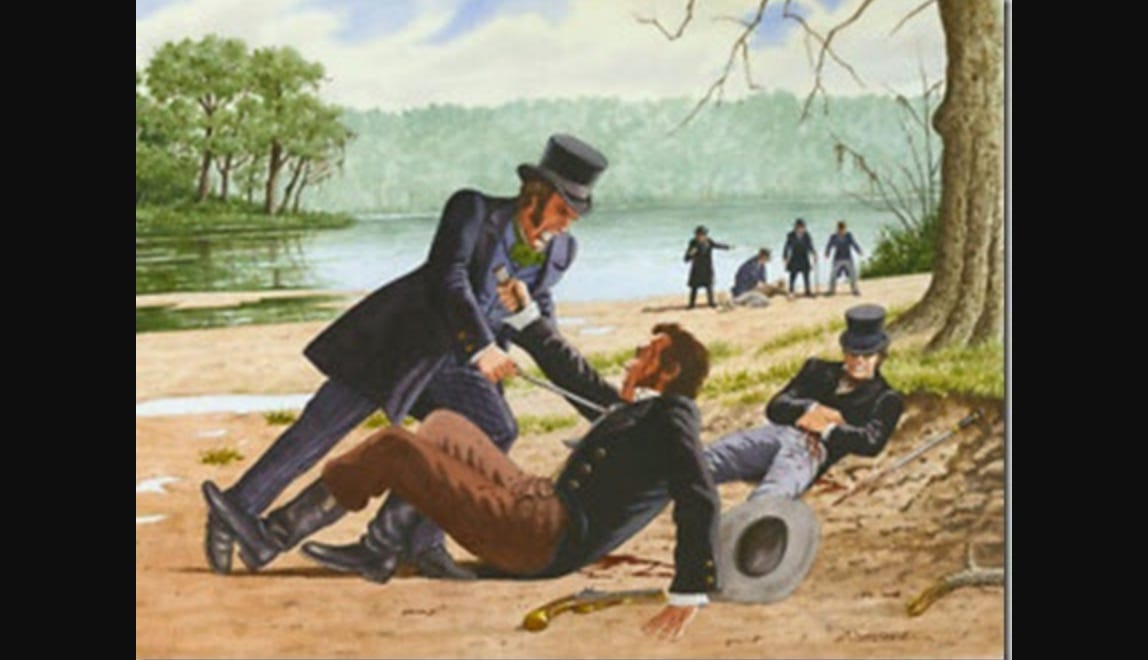There's a reason dueling is illegal
A rerun of a classic F&AB story documenting why you don't fight a guy who has a weapon named after him.
Welcome to Flashlight & A Biscuit, my Southern sports/culture/food offshoot of my work at Yahoo Sports. Thanks for reading, and if you’re new around here, why not subscribe?
I’m on one of those bucket-list vacations, and so here’s a tale that most of you missed the last time it came out way back in our 13th issue …
Consider, for a second, the courage-slash-stupidity it takes to stand in front of someone pointing a gun at you that you know they’re about to fire.
Consider, for another second, what a bad idea it is to fight a guy who’s got a weapon named after him.
And consider, for a third second, the kind of anarchy that results when you decide to schedule a duel on a sandbar in the middle of a river so you can avoid the laws of two states.
Our year is 1827. Our locale is a sandbar in the Mississippi River, on the border between Louisiana and Mississippi. Our occasion is a duel between the ranking members of the elite Wells and Cuny families. This is some real Mississippi Shakespeare stuff, with honor and debts and forbidden love and all that wrapped up here, but for the purposes of our story, we’ll begin with Samuel Wells III and Dr. Thomas H. Maddox standing on the sandbar pointing pistols at each other.
They missed their first shots.
Very deliberately, they reloaded. They took aim once again.
They missed their second shots.
And that should have been it. They shook hands; duel over, right? Except as everyone who’s ever been to a bar with that that one idiot friend who just will not keep his damn mouth shut, matters escalated between the entourages. Shouts flew, sabres were rattled, and eventually, bullets were fired.
When Wells and Maddox missed, they and the other four members of the dueling parties — the seconds and the surgeons — began celebrating together, which is strange as hell but we’ll let that ride for now. But some of the Wells entourage apparently weren’t satisfied with the outcome — ain’t no ties in SEC country, then or now — and charged the duelists. The Maddox crew then came in hot, and all hell broke loose.
Plenty of preexisting beef stood out on that sandbar that day. One key subplot: in an earlier dispute, a dude named Norris Wright had gone and shot Jim Bowie — yes, the later-Texas-famous Jim Bowie — and so Bowie came strapped for the inevitable rematch.
In the melee, Col. Robert Crain shot Bowie and then, as Bowie tried to get to his feet, Crain belted him with the butt of his pistol so hard that the gun broke. Wright, seeing his chance, fired at Bowie and missed, then just went ahead and charged at him. Wright pulled out a sword from his cane, James Bond villain-style, and plunged it at Bowie’s chest.
Unfortunately for Wright, the cheap cane sword hit Bowie in the sternum and bent. Bowie — who, again, had just been shot, brained and stabbed — drew his own weapon, a thick, short-blade knife, and pulled the John Wick-esque move of yanking Wright by the shirt down onto the blade. Wright died, as did Gen. Samuel Cuny from another gunshot, and it was at that point that everyone involved realized things had gotten a bit out of hand.
Wikipedia presents us with a handy box score:
I score Team Wells ahead of Team Maddox on points here, with the two “lightly injured” members of Team Maddox tipping the bout. (Nice of Wells and Maddox to skate without so much as a scratch, right?)
The fight would receive international attention, although it took months rather than seconds because nobody was around to post video to Twitter. In most accounts of the chaos, Bowie was the bout’s star. In the course of the 90-second fight, he reportedly suffered two bullet wounds, seven stab wounds and a possible concussion from getting clocked by a pistol butt, but was pretty much exonerated of Wright’s killing based on the “he had it comin’” defense.
The knife that Bowie used — with a crossguard and a clip-point blade — was the earliest version of the famous Bowie Knife, one of the most notable weapons in American history and one that we weren’t allowed to have in Boy Scouts but got our hands on anyway.
Bowie would go on to become a mythical figure in Texas history, a treasure hunter, rogue and revolutionary. (Lest we romanticize the guy too much, he was also heavily involved in slave trading.) He died at the Battle of the Alamo, allegedly fighting off Mexican soldiers while sick in bed.
Here’s a handy wrapup of the sandbar fight:
Best part of that video: the reminder that dueling is still illegal. You know, just in case you were itching to resolve a disagreement that way.
(Source: Natchez National Historical Park.)
That’ll do it for this week, friends. Back from vacation next week with a great Q&A with a Southern novelist you need to know. Catch you then!
—Jay
This is issue #79 of Flashlight & A Biscuit. Check out all the past issues right here. Feel free to email me with your thoughts, tips and advice. If you’re new around here, check out some of our recent hits:
How would Forrest Gump fare playing football for Alabama today?
Why Atlanta’s Varsity has the best burger ever. No, I’m serious.
Remembering Loretta Lynn, an icon without equal
We need a good Southern video game
Could you survive a Waffle House brawl?
What does “Flashlight & A Biscuit” mean, anyway?
If you dig this newsletter, share it with your friends. Invite others to the party, everyone’s welcome






